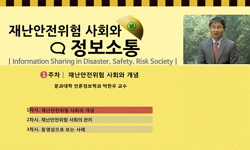Today, we live in a time when the whole society and country are more interested in disasters and management In this study, as one of the problems that needs to be solved in these historical situations, we are thinking of examining changes in the use o...
http://chineseinput.net/에서 pinyin(병음)방식으로 중국어를 변환할 수 있습니다.
변환된 중국어를 복사하여 사용하시면 됩니다.
- 中文 을 입력하시려면 zhongwen을 입력하시고 space를누르시면됩니다.
- 北京 을 입력하시려면 beijing을 입력하시고 space를 누르시면 됩니다.

재난 유형 관련 용어의 사용 추이와 사회적 인식의 변화 - 빅카인즈 뉴스 텍스트를 중심으로 - = Changes in the use of disaster type terms and social perceptions - Focusing on BIGKinds' news text -
한글로보기https://www.riss.kr/link?id=A107193431
- 저자
- 발행기관
- 학술지명
- 권호사항
-
발행연도
2020
-
작성언어
-
- 주제어
-
KDC
700
-
등재정보
KCI등재
-
자료형태
학술저널
-
수록면
1-32(32쪽)
- DOI식별코드
- 제공처
-
0
상세조회 -
0
다운로드
부가정보
다국어 초록 (Multilingual Abstract)
According to the research, unlike legal disasters divided into two categories: natural disasters and social disasters, the members of Korean society are divided into four categories: natural disasters, man-made disasters, social disasters, and combined disasters. Based on such categorization of the types of disasters, it can be said that the recognition that natural disasters brought about by natural phenomena are not simply unavoidable force majeure, but can be prevented and prepared as de facto man-made disasters as well as the recognition that the government is strongly required to respond to social disasters caused by defects in social structures and systems. It is also important that there is a widespread awareness of complex disasters, which refer to the occurrence of various disasters in a chain or simultaneous manner.
Considering that human history is simply a history of disasters, the BigKinds data shows only a change in the use and perception of disaster-related terms in a short period of only 30 years. However, it can be said that the results of this research are significant in that they allow us to grasp some aspects of actual language use and recognition, which are difficult to grasp in dictionaries and legal definitions and categorizations.
Today, we live in a time when the whole society and country are more interested in disasters and management In this study, as one of the problems that needs to be solved in these historical situations, we are thinking of examining changes in the use of disaster-type-related terms and social perceptions that are emerging in our society, focusing on the BigKinds news text.
According to the research, unlike legal disasters divided into two categories: natural disasters and social disasters, the members of Korean society are divided into four categories: natural disasters, man-made disasters, social disasters, and combined disasters. Based on such categorization of the types of disasters, it can be said that the recognition that natural disasters brought about by natural phenomena are not simply unavoidable force majeure, but can be prevented and prepared as de facto man-made disasters as well as the recognition that the government is strongly required to respond to social disasters caused by defects in social structures and systems. It is also important that there is a widespread awareness of complex disasters, which refer to the occurrence of various disasters in a chain or simultaneous manner.
Considering that human history is simply a history of disasters, the BigKinds data shows only a change in the use and perception of disaster-related terms in a short period of only 30 years. However, it can be said that the results of this research are significant in that they allow us to grasp some aspects of actual language use and recognition, which are difficult to grasp in dictionaries and legal definitions and categorizations.
동일학술지(권/호) 다른 논문
-
- 배달말학회
- 박용식 ( Park Yong-sik )
- 2020
- KCI등재
-
- 배달말학회
- 양정석 ( Yang Jeong-seok )
- 2020
- KCI등재
-
- 배달말학회
- 반재유 ( Ban Jae-yu )
- 2020
- KCI등재
-
안동하회별신굿 탈놀이의 지역정체성 획득 과정과 콘텐츠로서의 가치
- 배달말학회
- 유형동 ( Yoo Hyoung-dong )
- 2020
- KCI등재
분석정보
연관 공개강의(KOCW)
-

재난안전 위험사회와 정보소통
영남대학교 박한우 -

문학과 미술로 본 인간재난의 역사
충북권역센터 김성연 -

글로컬재난위기관리론
부산가톨릭대학교 정용준 -

재난관리 리더십과 재난대응 협업 (Disaster Management Leadership and Collaboration for Disaster Response)
K-MOOC 국가민방위재난안전교육원 NDTI International Cooperation Team -

재난커뮤니케이션 (Disaster Communication)
K-MOOC 국가민방위재난안전교육원 NDTI Int'l Cooperation Team




 KCI
KCI KISS
KISS

